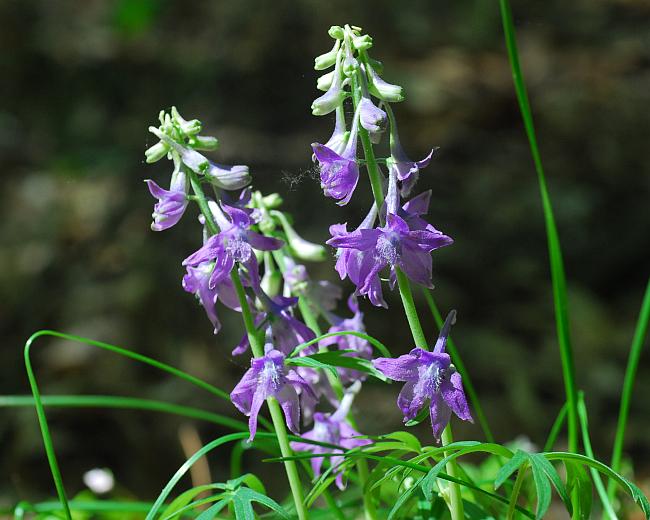Delphinium tricorne Michx.
Dwarf Larkspur

Native
CC = 6
CW = 5
MOC = 80
© SRTurner
Delphinium tricorne Michx.Dwarf Larkspur | |
 |
Native CC = 6 CW = 5 MOC = 80 |
© SRTurner |
|
Family - Ranunculaceae Habit - Perennial forb with thickened and often somewhat tuberous roots. Stems - Ascending to erect, to 60 cm, glabrous except in the inflorescence, hollow, typically simple. Leaves - Alternate, petiolate. Petioles of lower leaves to 15 cm long, hollow, sparsely to moderately pubescent. Rosette of basal leaves present at flowering; stem leaves 2-4 above the rosette. Leaf blades 2.8-6.5 cm long, 4.5-13.0 cm wide, deeply divided with the deepest divisions usually reaching the blade base; the ultimate leaf segments 2-11 mm wide, oblong to oblanceolate or occasionally linear, rounded or angled to a bluntly pointed tip.
Inflorescences - Terminal, narrow, bracteate racemes, the axis sparsely to moderately short-hairy, occasionally glabrous; the flower stalks ascending, but generally angled away from the inflorescence axis, the lowermost stalks 0.5-2.5(-5.8) cm long. Bracts to 9 mm long, 2 mm broad at base. Pedicels to 2 cm long, densely pubescent.
Flowers - Corolla strongly zygomorphic, typically +/- 3.5cm long and broad. Sepals pale to deep purple or blue, often tinged with white, sometimes all white, the lateral sepals 10-17 mm long, the spur 12-18 mm long, straight, but sometimes slightly upward-angled. Corollas of 4 free petals, these with the body 6-10 mm long, blue or occasionally white, the lower pair shallowly notched or lobed near the tip, sparsely white-hairy on the inner surface toward the base. Stamens about 20. Anthers brownish-black, to 1.5 mm long. Filaments white, glabrous, to 6 mm long, flattened below and broadest at base. Pistils 3. Ovaries pubescent, 4 mm long, 1.2 mm in diameter.
Fruit - Follicles 14-22 mm long, more or less spreading, those developing from a given flower divergent from their bases, glabrous or nearly so. Seeds 1.5-2.5 mm long, the outer surface finely wrinkled, brown to dark brown.
Flowering - April - May. Habitat - Bottomland and mesic forests, streambanks, bases and ledges of bluffs, ravines, railroads roadsides. Origin - Native to the U.S. Lookalikes - None close. Other species of Delphinium in the state are much taller. Other info. - This genus is a favorite of wildflower enthusiasts because of its interesting and showy flowers. The plant compensates for its small stature with showy inflorescences, which can be blue or white. It is fairly common across Missouri and much of the U.S. lower Midwest. The plant is easy to identify by virtue of its unusual flowers and short height. It is the most common larkspur occurring in Missouri. Photographs taken at the Hercules Glade Wilderness, Mark Twain National Forest, Taney County, MO., 4-21-00, by Tom's Creek, NC., 4-20-03, and at Reform Conservation Area, Callaway County, MO., 4-13-04 (DETenaglia); also along the Al Foster Trail near Glencoe, St. Louis County, MO, 4-20-2011, Weldon Spring Conservation Area, St. Charles County, MO, 4-6-2012 and 4-9-2012, Shaw Nature Reserve, Franklin County, MO, 5-8-2014, Salt Lick Point, near Valmeyer, Monroe County, IL, 4-30-2018, and Bootleg Access, Washington County, MO, 4-7-2020 (SRTurner). |